 |
Redwood Sail and Power
Squadrona unit of United States Power Squadrons®
Boating is fun..We'll show you
how |
 |
VHF/GPS DSC System
The Coast Guard’s new marine radio safety network,
"Rescue
21", is operational on the west coast, rescue centers now have the
ability to receive instant distress alerts from DSC-capable VHF marine radios;
however, approximately 90% of VHF DSC distress alerts received by the Coast
Guard do not contain position information, and approximately 60% do not contain
a registered MMSI identity. If you would like to take the
"Search" out of Search & Rescue and insure the
Coast Guard can quickly reach you in an emergency,
complete all the steps necessary to obtain an MMSI
identifier for your vessel and connect your GPS to your VHF radio so that
location information is available to the radio. Equipment manufacturers supply
the information required to make those connections in the User
Guide/Installation Guide for your GPS and VHF radio.
How to Install "Rescue 21" Capability on your Vessel.
Step 1: VHF Radio
- Purchase a Marine VHF Radio which has Digital Selective Calling
Capability (DSC).
-
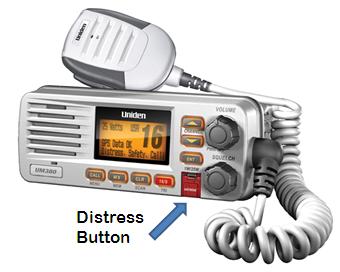 |
| Radios with DSC capability have a "Red" Distress button on the
front. |
Step 2: MMSI Number
- Obtain a "Maritime Mobile Service Identity" (MMSI) number.
- To utilize the Digital Selective Calling (DSC) capability of your VHF
for routine operations and for automated distress hailing you need an MMSI
number. MMSI is a fancy name for what is equivalent to a "phone number" for
your radio. It uniquely identifies your vessel. When you request the MMSI
number you supply the Coast Guard with a description of your boat. This
benefits you as when you press the "Distress" button on your radio and the
Coast Guard receives the distress call, your MMSI number is also transmitted
and they can retrieve the description of your boat to use in their Search and
Rescue efforts. The United States Power Squadrons is authorized to issue MMSIs
to US recreational boats. However if you plan to cruise to Mexico or Canada,
this is considered an international voyage and your must obtain your MMSI
directly from the Federal Communications Commission.
Step 3
- Enter the MMSI into your VHF Radio.
- Now that you have obtained your MMSI number, you must entered it into
your radio. The instructions for accomplishing this are contained in the User
Guide or Owner's Manual for your VHF radio. If you do not have the Owner's
Manual, go online to the manufacturer's website and download a copy of the
manual.
Global Positioning System (GPS) Receiver
- To insure the Coast Guard can find you quickly, attach a GPS receiver
to your VHF radio.
- The GPS must have NMEA 0183 outputs to share location information
with your DSC equipped VHF Radio.
- Once you follow the manufacturers instructions on how to attach the
GPS to the VHF, you will be able to automatically transmit location information
to the Coast Guard when you press the "Distress" button on the VHF.
- In non-emergency situations, you can send your location information
to a friend's DSC capable VHF radio. This might be helpful if you wanted to
communicate location information to each other.
-
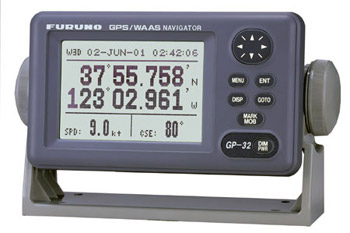 |
| GPS receivers come in many shapes and sizes. They can be simple
as the one shown above or they can be a full feature Chart Plotter. Both simple
and full featured ones can be interfaced to your VHF if they have NMEA 0183
outputs. The instructions will be in your Owner's Manual. The details will be
in the portion of the manual which describes installation procedures. |
Step 4: Connections
Now it is time to make the connections between the VHF Radio and the GPS
Receiver. Make sure you have the Owner's Manual/Installation Guide for each
piece of equipment.
- GPS Receiver/Chart Plotter: In the manual for this piece of
equipment, turn to the section that describes the wiring aspects of the
installation.
- There will be a diagram which indicated the color of the wires in the
wiring harness.
- Two of the wires go you your battery or electrical distribution
panel. Those will be "Red" for positive voltage and "Black" for the negative
voltage wire.
- You need to identify the wire colors for: (1) the "NMEA Out +" wire,
and (2) the "NMEA Out -" wire.
- In our example, the "NMEA Out +" will be "Yellow" and "NMEA Out -"
will be "Brown".
- Using the Installation Guide for the VHF radio, identify the wire
colors for (1) "NMEA In+" and "NMEA In -".
- In our example, the "NMEA In +" will be "Blue" and "NMEA In -" will
be "White".
- In the units are close enough together that the wires can be
connected without adding an additional length of wire, they may be connected as
shown below. In the illustration, a Blue Seas System 2402 Terminal Strip was
used.
- A wiring guide is available from the Coast Guard Navigation Center
at:
http://www.navcen.uscg.gov/pdf/marcomms/dsc/DSC_VHF_GPS_Install_Final.pdf
describing how popular GPS receivers and plotters can be properly
interconnected to a VHF marine radio. This tells exactly which colored wires
need to be connected to each other.
- A table which can be used as an aid for identifying which wires to
connect can be found at:
- VHF-GPS Wiring
Connections. Note that the table contains an example as well as a "blank"
worksheet, page 3, which you can complete with your information.
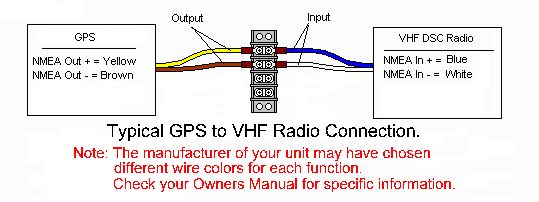
- As alternatives to a terminal strip, you could a 4-wire Flat Trailer
Light Plug if you would like to be able to remove the either the VHF or GPS or
both pieces of equipment from your boat. This is useful if you have an open
boat and are worried about the security of your electronics.
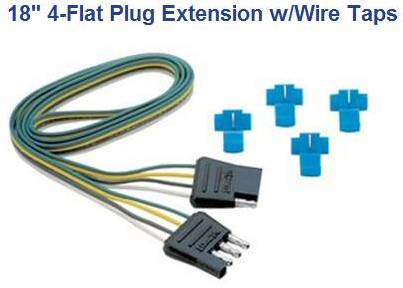
Step 5: Turn on the Equipment and Verify Proper Operation
- If you have properly connected the wires which allow the GPS to send
position data to your radio, you will see an image on the VHF display similar
to the one shown below. Note that the display contains latitude and longitude
information. It may also contains the time of day and an image of a satellite
which indicates a connection to the GPS.
-
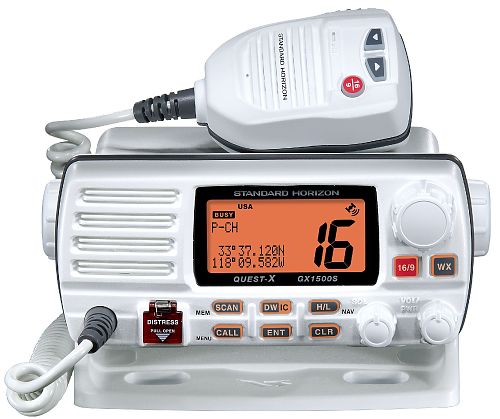 |
Note the satellite image in the top right corner and the
lattitude and longitude location information in the lower left corner. This
radio has been properly connected to the companion GPS receiver. This boater is
now ready to share his location information with other boaters. He has also
achieved the ability to have his radio send his location information to the
Coast Guard if an emergency occurs for which it is appropriate to press the
"Distress Button".
Caution: Do read your
VHF radio manual so you are familiar with the proper use of the "Distress"
Calling feature of your radio. |
Step 6: Proper VHF Usage
- Remeber, the VHF radio is your primary piece of safety gear when
boating. Following proper radio procedures will insure you can summon help when
needed.
-
- The United States Power Squadrons, in your area, offer a 2
hour seminar on the proper use of VHF/DSC radios. Contact your local Squadron
for Seminar
Information.
- Here is a link to online information on proper VHF Radio
usage: VHF Radio
Procedures |
Additional Information
Digital Selective Calling (DSC) Resources
VHF Radio Resources
YouTube Videos
|
Marine Electrical Reference Information
Tools
|
| |
Webmaster: Lt Mike Freeman








